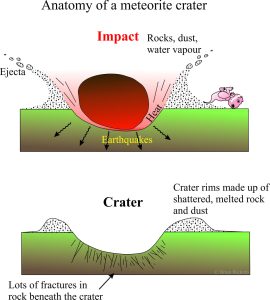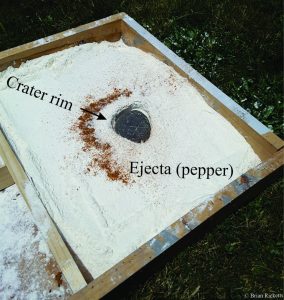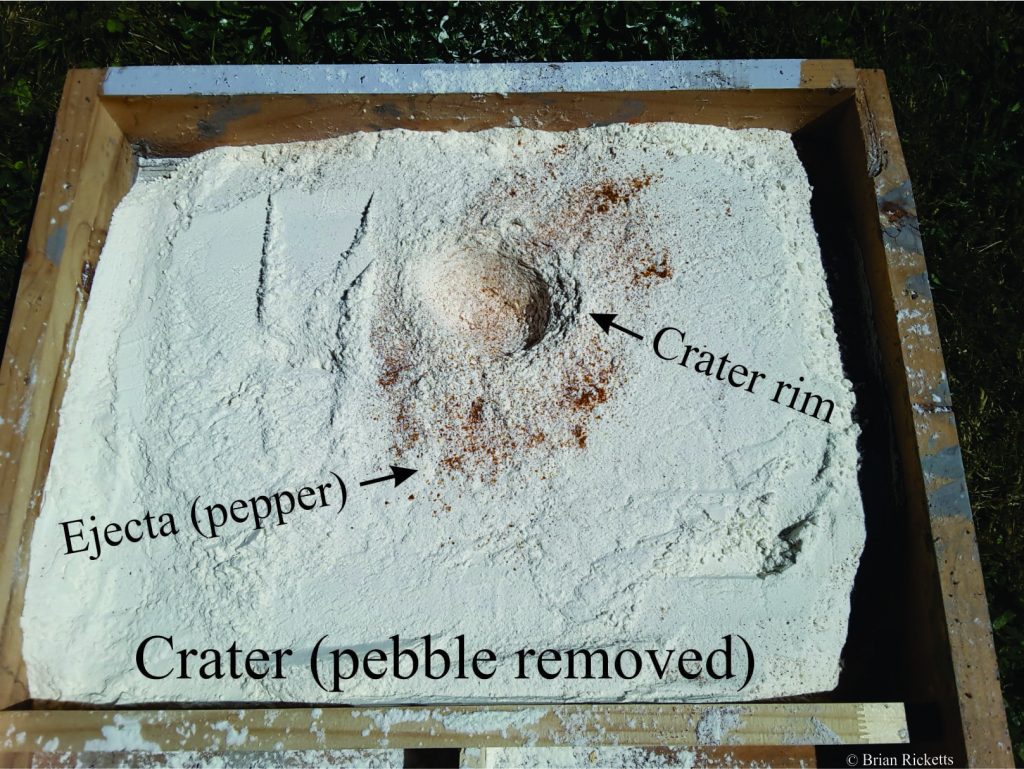 Click on the image to make it larger
Click on the image to make it larger
Make your own meteorite crater – comparing experiment with the real world
This post shows you how to make your own meteorite crater – it’s pretty easy. There are also many interesting questions we can ask of our experiments with craters, like “how do they compare with real craters?”
Meteorites in earth/solar system history
Meteorites, comets and asteroids have hammered earth, the moon and all the other planets since our solar system began, about 4.6 billion years ago. With just a small telescope you can see that the moon is peppered with craters. On earth, there have been some very big impacts that have led to extinction of all manner of life forms – perhaps the best known is the probable impact about 65 million years ago that hastened the demise of the dinosaurs.
In the less distant past (a mere 50,000 years ago) a meteorite estimated to be about 45m in diameter and traveling at 20km/second (= 72,000 km/hour) crashed into the Arizona desert leaving a crater about 1600m wide (the Barringer Crater).
Check out this short video on the solar system and meteorites.
On June 30, 1908 a massive explosion in eastern Siberia flattened trees over an area of about 2000 square kilometers. It is generally thought to have been caused by an exploding meteor; no crater has ever been found. More recently in 2013 a smaller meteor explode over Russia
Make you own meteorite crater
In this experiment you can try to duplicate some of the things that happen during a meteorite impact. You can make your own crater easily with some pretty basic equipment; and what’s more you can record it as images or videos on your smart-phone or tablet. All you need is:
- A small box with sides about 6-10 cm high (shoe box, wood or plastic tray).
- A couple of kg of (cheap) flour or something similar that is dry and really finely powdered.
- A small pebble.
- A small amount of darker coloured powder – I used cayenne pepper because it has a good contrast against the white flour.
- You can also demonstrate the impact in a bucket or pool of water.
Fill the box with flour until it is about 6-8cm deep. I created a small circular area of red pepper in the middle of the box. The red helps to delineate the shape of the ejected flour. Try to hit this red spot with the pebble, dropped from about 2m height (use a tall person to help you, or a chair or step-ladder). When you’re finished with the flour you can spread it on the compost, or if you have kept your experiment very clean, make some spicy cookies with it.
 I recorded the impact in water (a swimming pool) and in the flour box on my Tablet. There are several free Slow Motion Apps available that you can use to record the impact. You can then edit the video, add a title and captions in Windows Movie Maker or if you have it, something a bit more sophisticated. The slow motion allows you to see what happens to the water and flour on impact.
I recorded the impact in water (a swimming pool) and in the flour box on my Tablet. There are several free Slow Motion Apps available that you can use to record the impact. You can then edit the video, add a title and captions in Windows Movie Maker or if you have it, something a bit more sophisticated. The slow motion allows you to see what happens to the water and flour on impact.
Four short video clips show the results of 3 experiments in the flour box, and 1 in the pool.
In the real world, earth materials (rocks, soils, trees, water) are ejected (thrown up and out) on impact. In the case of the flour, the red pepper (as long as your aim was good) will spread out and give you an indication of how far the ejecta has been moved from its original spot. Flour is also thrown into the air; in the case of a large meteorite impact the dust will reach many kilometres into the upper atmosphere and have a major influence on global climate (it will tend to block sunlight). Note that the crater will also have a high rim made up of material thrown out during the impact. Land-based impacts can also generate lots of heat, but this is a bit more difficult to simulate here.
The meteorite (our pebble) impact in the pool sends a fair bit of water high into the air. In a real impact, this could result in huge volumes of water vapour in the atmosphere. However, the immediate and perhaps more spectacular effects are the large ripples, or tsunamis that spread out rapidly from the impact centre.
Some questions to ask of your experiment
One of the problems that scientific experiments like this have is what is referred to as a scale problem; our experiment is much smaller, slower and colder than real meteorite impacts. By asking questions about our experiment we can begin to learn something about these problems.
- How wide is the crater compared to the size/diameter of the pebble?
- What is the maximum distance of red pepper from the centre of the crater?
- Using your video, can you estimate the maximum height of the air-borne ejecta (flour)?
- How does the velocity of the pebble at impact compare with what we know of velocities of large meteorites that enter the atmosphere?
- We can take the last question a bit further if you like a bit of maths. Calculate the velocity (v) of the pebble at impact. The information you will need to do this is:
- Time taken to fall (in seconds) – this might be a bit tricky if the fall distance is small. Use a stop watch and try it several times without the flour box so you can calculate an average time. You can also make this task a bit easier by videoing the fall of the pebble in real time, then using the slow motion editor to measure the time at 0.5 times video speed, or 0.25 times video speed.
- Acceleration due to gravity (a) is 9.8m/s2, or 9.8m per second per second (acceleration is the rate at which velocity increases).
- The formula to calculate velocity at impact is:
- v (m/s) = v ( initial) + a.t
- But v ( initial) is zero, so in this case
- v = a.t
- How does your calculated velocity compare with real velocities?
- How successful was your experiment at simulating the real world of meteorite impacts?
HAVE FUN



















1 thought on “Make your own meteorite crater – comparing experiment with the real world”
good